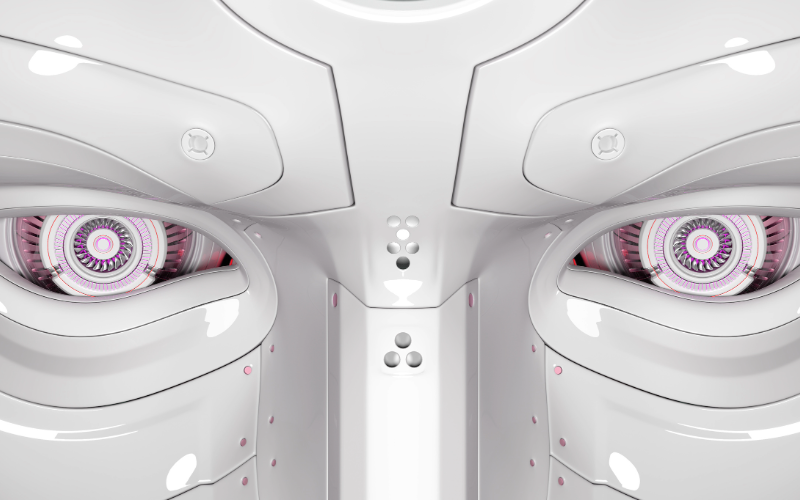
AI Anthropomorphism
Anthropomorphism, defined as the tendency to attribute human characteristics to non-human entities, is a phenomenon as old as humanity itself. From the earliest myths and legends where animals spoke or objects were alive, to today with advanced machines, this inclination reflects our need to understand and relate to our environment. In the field of technology, anthropomorphism has taken on a new meaning and purpose, particularly in the design and development of chatbots such as ChatGPT, Gemini or Copilot.
These conversational systems not only process information, but also adopt human language patterns to offer more natural interactions. This phenomenon has transformed the way we relate to machines, facilitating the integration of artificial intelligence (AI) into our daily lives.
Anthropomorphism in Chatbot Design
When we interact with a chatbot, we do so as if we were conversing with another person. This doesn't happen by chance, but is the result of a carefully crafted design to emulate human characteristics. These systems are programmed to use words and phrases that are understandable to us, but they go further by adopting communication patterns that are typical of humans, such as the use of humor, empathy, and even the ability to interpret context.
A chatbot, for example, not only answers direct questions, but can understand a more complex conversation, respond to emotional tones, or continue a previous conversation. This makes them seem less like machines and more like digital companions, which in turn improves our willingness to interact with them.
Purpose of Humanized Language
The design of humanized language in chatbots has clear objectives:
1. Facilitate interaction: Natural conversations reduce the technological barrier and make it possible for anyone, regardless of their technical skills, to comfortably interact with these tools.
2. Build trust: By communicating in an understandable and human-like manner, chatbots inspire greater confidence in users, who feel understood and cared for.
3. Expand their functionality: From answering simple questions to handling complex tasks, accessible language allows chatbots to be useful in a variety of contexts, such as customer service, education, healthcare, and entertainment.
Practical Applications of Anthropomorphism in Chatbots
The impact of this humanization of language can be seen in multiple areas:
1. Customer Service
Chatbots have revolutionized the way businesses interact with their customers. Their ability to maintain fluid conversations and resolve issues in real time makes them valuable tools for providing ongoing support. Additionally, by showing empathy and adapting to the user's tone, they significantly improve the customer experience.
2. Education
In the educational field, chatbots act as virtual tutors. They can explain complex concepts clearly, adapt their language to the user's level, and provide immediate feedback. This not only democratizes access to learning, but also makes it more interactive and dynamic.
3. Mental Health and Wellbeing
Some chatbots are designed to offer emotional support, using empathetic language to interact with people seeking guidance or simply wanting to be heard. While they are not a substitute for a professional therapist, they do represent an accessible first point of contact.
4. Entertainment
In the entertainment sector, chatbots add an interactive element, whether in video games, personalized narratives, or immersive experiences. Their ability to hold creative conversations and respond wittily makes them ideal for enriching these experiences.
Impact on Human Perception
The use of anthropomorphism in chatbots not only improves their functionality, but also influences our perception of technology. By appearing more human, these tools are more accessible and less intimidating to us. However, this humanization can also create challenges, such as the possibility that people may trust chatbots too much or feel emotionally attached to them.
In addition, there is an ethical debate surrounding the use of anthropomorphism in machines. On the one hand, this strategy facilitates the integration of AI into our lives; on the other, it raises concerns about the potential for emotional manipulation or the lack of transparency about the limits of chatbots' capabilities.
Challenges and Future of Anthropomorphism in AI
Anthropomorphism applied to chatbots is not without its challenges. Developers face the challenge of balancing the design of human interactions with ethical responsibility. Some key questions include:
- To what extent is it acceptable for a chatbot to look human?
- How to ensure that users understand that they are interacting with a machine and not a real person?
- What boundaries should be set to prevent emotional manipulation?
In the future, chatbots are likely to continue to evolve, incorporating not only more sophisticated language, but also the ability to interpret gestures or facial expressions in more immersive interactions.
Anthropomorphism in chatbots is not simply a design detail; it is a bridge that connects humans to technology in a more intuitive and natural way. By giving machines human characteristics, new possibilities are opening up for their use in fields such as customer service, education, health and entertainment.
However, this trend also invites us to reflect on how we want our relationship with machines to be. The key is to use anthropomorphism to improve the quality of life, without losing sight of the ethical limits and responsibility that comes with humanizing machines. In this delicate balance, chatbots will continue to be a fundamental tool for building a more connected and accessible future.
"Anthropomorphism in conversational AI is a powerful tool that facilitates technological adoption. People feel more comfortable interacting with systems that mimic human patterns, which reduces friction in the user experience. However, it also carries risks, such as generating unrealistic expectations about the capabilities of artificial intelligence."
MCE. Mauricio Eberle Morales
CDO, Sastrería Web


